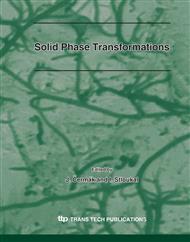[1]
G. Humpsten and D.M. Jacobson: Principles of Soldering and Brazing (ASM International, Materials Park, OH 1993).
Google Scholar
[2]
D. M Jacobson and S.P. S Sangha: Novel Applications of Diffusion Soldering (GEC-Marconi Materials Technology Ltd, Hirst Division, Hertfordshire, England 1995).
Google Scholar
[3]
P.K. Khanna, S.K. Bhatnagar, G. Dalke, D. Brunner and W. Gust: Mat. Sci. Eng. B Vol. 33 (1995), p. l6.
Google Scholar
[4]
S.K. Kang, W.K. Choi, D.Y. Shih, D.W. Henderson, T. Gosselin, A. Sarkhel, C. Goldsmith and K.J. Puttlitz: JOM Vol. 55 (2003), p.61.
DOI: 10.1007/s11837-003-0143-6
Google Scholar
[5]
COST 531 Lead free solder materials, database.
Google Scholar
[6]
J. Wojewoda and P. Zięba: InŜynieria Materiałowa Vol. 24 (2004), p.460.
Google Scholar
[7]
H. Fidos and H. Schreiner: Z. Metallkd. Vol. 61 (1971), p.225.
Google Scholar
[8]
S. Bader, W. Gust and H. Hieber: Acta Metall. Mater. Vol. 43 (1995), p.329.
Google Scholar
[9]
C.R. Kao: Mat. Sci. Eng. A Vol. 238 (1997), p.196.
Google Scholar
[10]
D. Gur and M. Bamberger: J. Mater. Sci. Vol. 35 (2000), p.4601.
Google Scholar
[11]
P.G. Kim and K.N. Tu: Mater. Chem. Phys. Vol. 53 (1998), p.165.
Google Scholar
[12]
J.A. van Beck, S.A. Stolk and F.J.J. van Loo: Z. Metallkd. Vol. 73 (1982), p.439.
Google Scholar
[13]
T. Ishida: Trans. JIM Vol. 14 (1973), p.37.
Google Scholar
[14]
C. Tsao and S. Chen: J. Mater. Sci. Vol. 30 (1995), p.5215.
Google Scholar
[15]
Y.M. Liu and T.H. Chuang: J. Electron. Mater. Vol. 29 (2000), p.405.
Google Scholar
[16]
Y.H. Tseng, M.S. Yeh and T.H. Chuang: J. Electron. Mater. Vol. 28 (1999), p.105.
Google Scholar
[17]
H.K. Kim, H.K. Liou and K.N. Tu: Appl. Phys. Lett. Vol. 66 (1995), p.2337.
Google Scholar
[18]
M. Schaefer, R.A. Fournelle and J. Liang: J. Electron. Mater. Vol. 27 (1998), p.1167.
Google Scholar
[19]
A.D. Romig Jr., F.G. Yost and P.F. Hlava, in: Proc. Microbeam Analysis 1984, edited by A.D. Romig, Jr. and J.I. Goldstein, San Francisco Press, CA, San Francisco (1984).
Google Scholar
[20]
J.B. Clark: Trans. Metal. Soc. AIME Vol. 227, (1963) 1250.
Google Scholar
[21]
B. Pieraggi: Oxid. Met. Vol. 27 (1987), p.177.
Google Scholar
[22]
S. Sommadossi, W. Gust and E.J. Mittemeijer: Mater. Chem. Phys. Vol. 77 (2002), p.924.
Google Scholar


